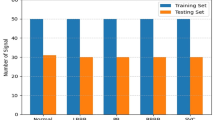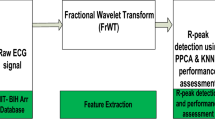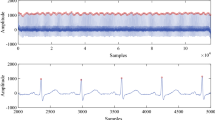Abstract
The cardiac activities such as the depolarization and the relaxation of atria and ventricles are observed in electrocardiogram (ECG). The changes in the morphological features of ECG are the symptoms of particular heart pathology. It is a cumbersome task for medical experts to visually identify any subtle changes in the morphological features during 24 hours of ECG recording. Therefore, the automated analysis of ECG signal is a need for accurate detection of cardiac abnormalities. In this paper, a novel method for automated detection of cardiac abnormalities from multilead ECG is proposed. The method uses multiscale phase alternation (PA) features of multilead ECG and two classifiers, k-nearest neighbor (KNN) and fuzzy KNN for classification of bundle branch block (BBB), myocardial infarction (MI), heart muscle defect (HMD) and healthy control (HC). The dual tree complex wavelet transform (DTCWT) is used to decompose the ECG signal of each lead into complex wavelet coefficients at different scales. The phase of the complex wavelet coefficients is computed and the PA values at each wavelet scale are used as features for detection and classification of cardiac abnormalities. A publicly available multilead ECG database (PTB database) is used for testing of the proposed method. The experimental results show that, the proposed multiscale PA features and the fuzzy KNN classifier have better performance for detection of cardiac abnormalities with sensitivity values of 78.12 %, 80.90 % and 94.31 % for BBB, HMD and MI classes. The sensitivity value of proposed method for MI class is compared with the state-of-art techniques from multilead ECG.



Similar content being viewed by others
References
Drezner, J. A., Ashley, E., Baggish, A. L., Börjesson, M., Corrado, D., Owens, D. S., Patel, A., Pelliccia, A., Vetter, V. L., Ackerman, M. J., et al. Abnormal electrocardiographic findings in athletes: recognising changes suggestive of cardiomyopathy. Br. J. Sports Med. 47(3):137–152, 2013.
Goldberger, A. L. Clinical electrocardiography: a simplified approach: Elsevier Health Sciences, 2012.
Thygesen, K., Alpert, J. S., Jaffe, A. S., White, H. D., Simoons, M. L., Chaitman, B. R., Katus, H. A., Apple, F. S., Lindahl, B., Morrow, D. A., et al., Third universal definition of myocardial infarction. J. Am. Coll. Cardiol. 60(16):1581–1598, 2012.
Sharma, L., Tripathy, R., and Dandapat, S., Multiscale energy and eigenspace approach to detection and localization of myocardial infarction. IEEE Trans. Biomed. Eng. 62(7):1827–1837, 2015.
Martis, R. J., Acharya, U. R., and Adeli, H., Current methods in electrocardiogram characterization. Comput. Biol. Med. 48:133–149, 2014.
Lin, B. -S., Wong, A. M., and Tseng, K. C., Community-based ecg monitoring system for patients with cardiovascular diseases. J. Med. Syst. 40(4):1–12, 2016.
Alshraideh, H., Otoom, M., Al-Araida, A., Bawaneh, H., and Bravo, J., A web based cardiovascular disease detection system. J. Med. Syst. 39(10):1–6, 2015.
Rahman, Q. A., Tereshchenko, L. G., Kongkatong, M., Abraham, T., Abraham, M. R., and Shatkay, H., Utilizing ecg-based heartbeat classification for hypertrophic cardiomyopathy identification. IEEE Trans. NanoBioscience 14(5):505–512, 2015.
Arif, M., Malagore, I. A., and Afsar, F. A., Detection and localization of myocardial infarction using k-nearest neighbor classifier. J. Med. Syst. 36(1):279–289, 2012.
Lu, H., Ong, K., and Chia, P., An automated ecg classification system based on a neuro-fuzzy system. In: Computers in Cardiology 2000, pp. 387–390: IEEE (2000)
Sun, L., Lu, Y., Yang, K., and Li, S., Ecg analysis using multiple instance learning for myocardial infarction detection. IEEE Trans. Biomed. Eng. 59(12):3348–3356, 2012.
Liu, B., Liu, J., Wang, G., Huang, K., Li, F., Zheng, Y., Luo, Y., and Zhou, F., A novel electrocardiogram parameterization algorithm and its application in myocardial infarction detection. Comput. Biol. Med. 61:178–184, 2015.
Alickovic, E., and Subasi, A., Medical decision support system for diagnosis of heart arrhythmia using dwt and random forests classifier. J. Med. Syst. 40(4):1–12, 2016.
Jayachandran, E. et al., Analysis of myocardial infarction using discrete wavelet transform. J. Med. Syst. 34(6):985–992, 2010.
Haraldsson, H., Edenbrandt, L., and Ohlsson, M., Detecting acute myocardial infarction in the 12-lead ecg using hermite expansions and neural networks. Artif. Intell. Med. 32(2):127–136, 2004.
Acharya, U. R., Fujita, H., Sudarshan, V. K., Oh, S. L., Adam, M., Koh, J. E., Tan, J. H., Ghista, D. N., Martis, R. J., Chua, C. K., et al., Automated detection and localization of myocardial infarction using electrocardiogram: a comparative study of different leads. Knowl.-Based Syst. 99:146–156, 2016.
Lahiri, T., Kumar, U., Mishra, H., Sarkar, S., and Das Roy, A., Analysis of ecg signal by chaos principle to help automatic diagnosis of myocardial infarction. J. Sci. Ind. Res. 68(10):866, 2009.
Safdarian, N., Dabanloo, N. J., and Attarodi, G., A new pattern recognition method for detection and localization of myocardial infarction using t-wave integral and total integral as extracted features from one cycle of ecg signal. J. Biomed. Sci. Eng. 7(10):818, 2014.
Tripathy, R., Sharma, L., and Dandapat, S., A new way of quantifying diagnostic information from multilead electrocardiogram for cardiac disease classification. Healthcare Technol. Lett. 1(4):98, 2014.
Martis, R. J., Acharya, U. R., Mandana, K., Ray, A., and Chakraborty, C., Application of principal component analysis to {ECG} signals for automated diagnosis of cardiac health. Expert Syst. Appl. 39(14):11792–11800, 2012. [Online]. Available: http://www.sciencedirect.com/science/article/pii/S0957417412006690.
Martis, R. J., Acharya, U. R., Mandana, K., Ray, A. K., and Chakraborty, C., Cardiac decision making using higher order spectra. Biomedical Signal Process. Control 8(2):193–203, 2013.
Huang, K., and Zhang, L., Cardiology knowledge free ecg feature extraction using generalized tensor rank one discriminant analysis. EURASIP J. Adv. Signal Process. 2014(1):1–15, 2014.
Oppenheim, A. V., and Lim, J. S., The importance of phase in signals. Proc. IEEE 69(5):529–541, 1981.
Thomas, M., Das, M. K., and Ari, S., Automatic ecg arrhythmia classification using dual tree complex wavelet based features. AEU-Int. J. Electron. Commun. 69(4):715–721, 2015.
Selesnick, I. W., Baraniuk, R. G., and Kingsbury, N. G., The dual-tree complex wavelet transform. IEEE Signal Proc. Mag. 22(6):123–151, 2005.
Rangayyan, R. M. Biomedical signal analysis. Vol. 33: Wiley, 2015.
Kingsbury, N., A dual-tree complex wavelet transform with improved orthogonality and symmetry properties. In: Image Processing, 2000 International Conference on Proceedings, Vol. 2, pp. 375–378: IEEE, 2000.
Takla, G., Loparo, K. A., and Nair, B.: System for artifact detection and elimination in an electrocardiogram signal recorded from a patient monitor. May 7 2008, uS Patent App. 12/116, 235
Selesnick, I. W., Hilbert transform pairs of wavelet bases. IEEE Signal Process. Lett. 8(6):170–173, 2001.
Zhang, J., Jiang, W., Wang, R., and Wang, L., Brain mr image segmentation with spatial constrained k-mean algorithm and dual-tree complex wavelet transform. J. Med. Syst. 38(9):1–6 , 2014.
Tripathy, R., Sharma, L., and Dandapat, S., Detection of shockable ventricular arrhythmia using variational mode decomposition. J. Med. Syst. 40(4):1–13, 2016.
Pohjalainen, J., Räsänen, O., and Kadioglu, S., Feature selection methods and their combinations in high-dimensional classification of speaker likability, intelligibility and personality traits. Comput. Speech Lang. 29(1): 145–171, 2015.
Bejani, M., Gharavian, D., and Charkari, N. M., Audiovisual emotion recognition using anova feature selection method and multi-classifier neural networks. Neural Comput. & Applic. 24(2):399–412, 2014.
Bishop, C. M., Pattern recognition. Mach. Learn., 2006.
Keller, J. M., Gray, M. R., and Givens, J. A., A fuzzy k-nearest neighbor algorithm. IEEE Trans. Syst. Man Cybern. 4:580–585, 1985.
Arif, M., Akram, M. U., et al., Pruned fuzzy k-nearest neighbor classifier for beat classification. J. Biomed. Sci. Eng. 3(04):380, 2010.
Sokolova, M., and Lapalme, G., A systematic analysis of performance measures for classification tasks. Inf. Process. Manag. 45(4):427–437, 2009.
Oeff, M., Koch, H., Bousseljot, R., and Kreiseler, D.: The ptb diagnostic ecg database. National Metrology Institute of Germany, http://www.physionet.org/physiobank/database/ptbdb, 2012.
Heiberger, R. M., and Neuwirth, E., One-way anova. In: R through excel, pp. 165–191: Springer 2009.
Tsutsumi, T., Okamoto, Y., Kubota-Takano, N., Wakatsuki, D., Suzuki, H., Sezaki, K., Iwasawa, K., and Nakajima, T., Time–frequency analysis of the qrs complex in patients with ischemic cardiomyopathy and myocardial infarction. IJC Heart Vessel. 4:177–187, 2014.
Dandapat, S., Sharma, L., and Tripathy, R., Quantification of diagnostic information from electrocardiogram signal: A review. In: Advances in communication and computing, pp. 17–39: Springer (2015)
Acknowledgments
The authors are grateful to editor-in-chief and associate editor of journal of medical systems for encouragement and would like to thank reviewers for their valuable suggestions to for revising this manuscript.
Author information
Authors and Affiliations
Corresponding author
Additional information
This article is part of the Topical Collection on Systems-Level Quality Improvement
Rights and permissions
About this article
Cite this article
Tripathy, R.K., Dandapat, S. Detection of Cardiac Abnormalities from Multilead ECG using Multiscale Phase Alternation Features. J Med Syst 40, 143 (2016). https://doi.org/10.1007/s10916-016-0505-6
Received:
Accepted:
Published:
DOI: https://doi.org/10.1007/s10916-016-0505-6




